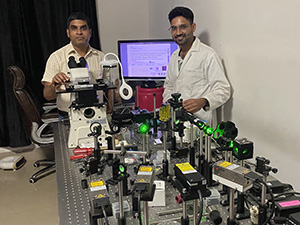MANDI: Researchers at the Indian Institute of Technology Mandi in collaboration with the University of Cincinnati, USA, has developed an efficient method to study the internal structure and functions of an important component of living cells.
The researchers have used metal nanoclusters in a method called Structured Illumination Microscopy to observe the nanodimensional features and functions of lysosomes and their interactions with another important cell organelle, mitochondria.
The results of this work have been published in the prestigious journal – American Chemical Society Materials Letters.
The paper is co-authored by Prof. Chayan K. Nandi, School of Basic Sciences, IIT Mandi and his research scholar Mr. Aditya Yadav from IIT Mandi, along with Dr. Kangqiang Qiu, Dr. Zhiqi Tian, Dr. Ziyuan Guo, Dr. Donglu Shi, and Dr. Jiajie Diao from the University of Cincinnati. USA.
A lysosome is an essential component of living cells. It is involved in various cell processes and interacts with other cell components like the mitochondria.
Lysosomes destroy invading viruses and bacteria. If the cell is damaged beyond repair, lysosomes can help it self-destruct, thereby earning the moniker “suicide bag”. Lysosomal dysfunction can cause a wide range of diseases including neurodegenerative disorders, immune system disorders, cancer, etc.
Therefore, the analysis and tracking of lysosomes structure and function can help predict risks for certain diseases and also guide the development of new pharmaceuticals for those diseases.
While explaining the need to develop new methods to see into these tiny structures, Prof. Chayan K. Nandi, IIT Mandi, said, “Lysosomes are about a micron in size, i.e., a thousandth of a millimetre, with its internal structure in the order of 200 nanometres (one thousandth of a micron). The regular microscope cannot pick up the details of structures of this size.”
IIT Mandi researchers have used a technique called Structured Illumination Microscopy (SIM) to discern the internal structures of lysosomes.
SIM is based on the excitation of the sample with a structured pattern of light and the detection of the interference patterns by Near infrared spectroscopy.
While SIM is not a new technique in itself, the novelty of this inter-institutional work is in the use of metal nanoclusters instead of lysosomal dyes that are usually used for this analytical technique, thereby improving the technique significantly.
The normal dyes that are used for lysosomal detection by SIM are sensitive to the acidity of the medium, and are also photobleached with time.
The researchers have used tiny clusters of noble metals such as gold and silver, one hundred thousand times smaller than the width of a single human hair (nanoclusters), instead of lysosomal dyes to study the internal structure of this organelle by SIM.
While explaining the research, Mr Aditya Yadav, Research Scholar, IIT Mandi, said, “We modified these nanoclusters with a biocompatible protein called bovine serum albumin and used them to track the dynamics of the lysosomes in brain organoid.
In particular, we studied the process by which lysosomes recycle damaged mitochondria inside cells.”
The protein-coated metal nanoclusters could be used to track lysosome activity for an extended period of time (more than 12 days), which provided ample opportunity to study the dynamics of fission, fusion, and kiss-and-run processes associated with the interactions between the ribosomes and mitochondria.
Furthermore, as expected, these nanoclusters did not have any photo-bleaching problems, and also were not influenced by the acidity of the medium, unlike organic dyes used for the purpose.
Since these nanoclusters were small enough to enter the cells and even enter the sub cellular structures such as the lysosome, it can be used to understand the functioning of these vital substructures of the cells.





